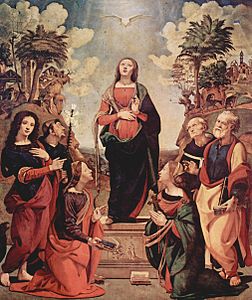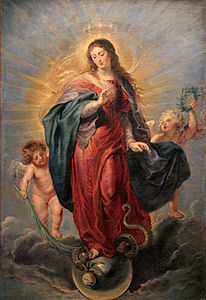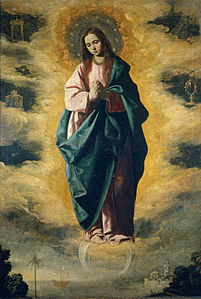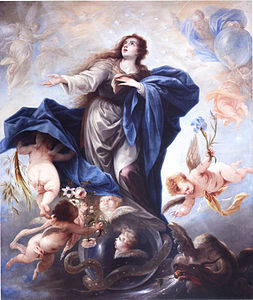Kukingiwa dhambi ya asili

Kukingiwa dhambi ya asili ni fundisho rasmi la Kanisa Katoliki kuhusu Bikira Maria, kwamba alitungwa mimba bila kurithi dhambi ya asili na kwamba alipewa na Mungu fadhili hiyo kwa kutanguliziwa stahili za Yesu Kristo, mwanae[2]
Kadiri ya imani hiyo Maria, akiwa kweli amejaa neema na mbarikiwa kati ya wanawake, kwa kutazamia uzazi na kifo cha Mwana wa Mungu kitakacholeta wokovu, tangu nukta ya kwanza ya kutungwa mimba alikingiwa doa lolote la dhambi[3].
Dogma hiyo ilitangazwa kwa fahari na Papa Pius IX kutokana na mapokeo ya kale sana [4].
Historia
[hariri | hariri chanzo]Imani hiyo katika utakatifu usio na doa wa Maria ilishikwa na Wakristo tangu kale[5].
Hata hivyo mjadala wa wanateolojia uliendelea muda mrefu kuhusu uwezekano wa fadhili hiyo kuhusiana na imani ya kwamba Mkombozi pekee wa binadamu wote ni Yesu.
Kati ya watetezi wakuu wa fadhili hiyo walijitokeza Ndugu Wadogo, kuanzia Yohane Duns Skoto[6].
Hatimaye dogma hiyo ilitangazwa mwaka 1854 kwa hati Ineffabilis Deus ya Papa Pius IX.[7][8]
Miaka minne baadaye huko Lurdi mtoto Bernadeta Soubirous alisema kuwa ametokewa mara kadha na mwanamke ambaye hatimaye alijitambulisha "Ndimi Kukingiwa Dhambi ya Asili".[9]
Katika liturujia
[hariri | hariri chanzo]Kanisa la Kilatini linaadhimisha fumbo hilo kama sherehe tarehe 8 Desemba[10]. Siku hiyo katika nchi mbalimbali ni sikukuu ya amri kwa Wakatoliki, na pengine sikukuu ya kitaifa.[11]

Katika Uislamu
[hariri | hariri chanzo]Mafundisho ya Uislamu juu ya ubora wa Bikira Mariamu yanafanana kiasi na imani hiyo[12][13][14].
Picha
[hariri | hariri chanzo]-
Mchoro wa Piero di Cosimo, 1505
-
Mchoro wa Rubens, 1628-1629
-
Mchoro wa Zurbarán, 1630
-
Mchoro wa Murillo, 1650
-
Mchoro wa Murillo, 1660
-
Mchoro wa Murillo, 1678
-
Mchoro wa Carlo Maratta, 1689
-
Mchoro wa Juan Antonio Escalante 17th century
Tanbihi
[hariri | hariri chanzo]- ↑ Raymond Burke, 2008, Mariology: A Guide for Priests, Deacons,seminarians, and Consecrated Persons Queenship Publishing ISBN 1-57918-355-7 page [1]
- ↑ Catechism of the Catholic Church, 490-493
- ↑ https://www.santiebeati.it/dettaglio/20600
- ↑ When defining the dogma in Ineffabilis Deus, Pope Pius IX explicitly affirmed that Mary was redeemed in a manner more sublime. He stated that Mary, rather than being cleansed after sin, was completely prevented from contracting Original Sin in view of the foreseen merits of Jesus Christ, the Savior of the human race. In Luke:1:47, Mary proclaims: "My spirit has rejoiced in God my Saviour." This is referred to as Mary's pre-redemption by Christ. Since the Second Council of Orange against semi-pelagianism, the Catholic Church has taught that even had man never sinned in the Garden of Eden and was sinless, he would still require God's grace to remain sinless.
- ↑ A feast of the Conception of the Most Holy and All Pure Mother of God was celebrated in Syria on 8 December perhaps as early as the 5th century.
- ↑ Proposing a solution to the theological problem of reconciling the doctrine with that of universal redemption in Christ, he argued that Mary's immaculate conception did not remove her from redemption by Christ; rather it was the result of a more perfect redemption granted her because of her special role in salvation history. Scotus's arguments remained controversial, however, particularly among the Dominicans, who were willing enough to celebrate Mary's sanctificatio (being made free from sin) but, following the Dominican Thomas Aquinas' arguments, continued to insist that her sanctification could not have occurred until after her conception. Encyclopedia of theology: a concise Sacramentum mundi by Karl Rahner 2004 ISBN 0-86012-006-6 pages 896-898
- ↑ "the doctrine which holds that the most Blessed Virgin Mary, in the first instance of her conception, by a singular grace and privilege granted by Almighty God, in view of the merits of Jesus Christ, the Saviour of the human race, was preserved free from all stain of original sin" (Encyclical Ineffabilis Deus of Pope Pius IX Ilihifadhiwa 14 Machi 2013 kwenye Wayback Machine.)
- ↑ The papal bull defining the dogma, Ineffabilis Deus, mentioned in particular the patrististic interpretation of Genesis 3:15 as referring to a woman, Mary, who would be eternally at enmity with the evil serpent and completely triumphing over him. It said the Fathers saw foreshadowings of Mary's "wondrous abundance of divine gifts and original innocence" "in that ark of Noah, which was built by divine command and escaped entirely safe and sound from the common shipwreck of the whole world; in the ladder which Jacob saw reaching from the earth to heaven, by whose rungs the angels of God ascended and descended, and on whose top the Lord himself leaned: Genesis 28:12; in that bush which Moses saw in the holy place burning on all sides, which was not consumed or injured in any way but grew green and blossomed beautifully: Exodus 3:2; in that impregnable tower before the enemy, from which hung a thousand bucklers and all the armor of the strong: Song 4:4; in that garden enclosed on all sides, which cannot be violated or corrupted by any deceitful plots: Song 4:12; in that resplendent city of God, which has its foundations on the holy mountains: Psalm 87:1; in that most august temple of God, which, radiant with divine splendours, is full of the glory of God: Isaiah 6:1-4; and in very many other biblical types of this kind." The bull recounts that the Fathers interpreted the angel's address to Mary, "highly favoured one" or "full of grace" (Luke 1:28) as indicating that "she was never subject to the curse and was, together with her Son, the only partaker of perpetual benediction"; they "frequently compare her to Eve while yet a virgin, while yet innocence, while yet incorrupt, while not yet deceived by the deadly snares of the most treacherous serpent".
- ↑ Vatican website
- ↑ Martyrologium Romanum
- ↑ "Christianity: Immaculate Conception". BBC. Iliwekwa mnamo 25 Mei 2014.
{{cite web}}: CS1 maint: date auto-translated (link) - ↑ Thomas Patrick Hughes, A Dictionary of Islam. First published London 1885; reprinted by Asian Educational Services 2001. ISBN 8120606728, ISBN 9788120606722. Entry "IMMACULATE CONCEPTION". (Google Books) Quote: "This doctrine was asserted by Muhammad (Mishkāt, book i., ch. iii., pt. 1)."
- ↑ William Bernard Ullathorne. The Immaculate Conception of the Mother of God: An Exposition. First published 1855; ISBN 1-110-89977-7. Chapter XIV, "Mahomet and Martin Luther". (Google Books)
- ↑ Giancarlo Finazzo. "The Virgin Mary in the Koran" Ilihifadhiwa 6 Agosti 2016 kwenye Wayback Machine.. L'Osservatore Romano Weekly Edition in English, 13 April 1978, page 4. Quote: "The dogma of the Immaculate Conception ... is univocally recognized by the Islamic religion."
Marejeo
[hariri | hariri chanzo]- Le Franc, Martin. The Conception of Mary -- A Rhyming Translation of Book V of Le Champion des Dames by Martin Le Franc (1410-1461). Ed. and trans. Steven Millen Taylor. Lewiston, NY: The Edwin Mellen Press, 2010.
Viungo vya nje
[hariri | hariri chanzo]- The Immaculate Conception in Art (Painting)
- Ineffabilis Deus (Apostolic Constitution of Pope Pius IX defining the dogma of the Immaculate Conception)
- [2] Godzinki: The Little Hours of the Immaculate Conception
- St. Alphonsus Liguori's writing on the Immaculate Conception in his book The Glories of Mary
- Catholic Encyclopedia entry on the Immaculate Conception
- Catholic Encyclopedia entry on Original Sin
- The Immaculate Conception. A study by a Melkite archimandrite Ilihifadhiwa 10 Mei 2007 kwenye Wayback Machine.
- The Immaculate Conception of the Mother of God Ilihifadhiwa 14 Desemba 2016 kwenye Wayback Machine. based on Juniper Carol's Mariology and William Bernard Ullathornee's book
- "St. Augustine and Original Sin" — a short article on the different understandings of Original Sin in Eastern and Western Christianity, without distinguishing Protestant theology from Roman Catholic. The latter holds that "original sin does not have the character of a personal fault in any of Adam's descendants" (Catechism of the Catholic Church, 405).
- Mark I. Miraville (editor), "Mariology: A Guide for Priests, Deacons, Seminarians, and Consecrated Persons
- Original Sin According To St. Paul by John S. Romanides
- Catechism of the Catholic Church "Conceived by the Power of the Holy Spirit and Born of the Virgin Mary"
| Makala hii kuhusu dini ya Ukristo bado ni mbegu. Je, unajua kitu kuhusu Kukingiwa dhambi ya asili kama historia yake, matokeo au athari zake? Labda unaona habari katika Wikipedia ya Kiingereza au lugha nyingine zinazofaa kutafsiriwa? Basi unaweza kuisaidia Wikipedia kwa kuihariri na kuongeza habari. |











